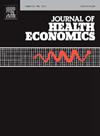Social genetic insurance: A life-cycle perspective
IF 3.6
2区 经济学
Q1 ECONOMICS
引用次数: 0
Abstract
Temporal risk aversion can justify a social genetic insurance scheme, even in the absence of reclassification risk. I model individuals who take a genetic test in period 0 and may become ill in period 2. I show that redistributing from low-risk to high-risk individuals in period 1 can increase social welfare, even when the high-risk are not financially penalized. Temporally risk-averse individuals value reductions in the risk to their lifetime utility brought by illness, such as increased morbidity and mortality. A social insurance can achieve this by taxing the low-risk and subsidizing the high-risk. I calibrate a multi-period life-cycle model for breast cancer and Huntington’s disease and quantify the optimal redistribution. For these two conditions, which are rare, substantial transfers to the high-risk can be achieved with minimal taxation on the low-risk. Thus, the welfare of the high-risk is substantially improved with little impact on the low-risk.
社会遗传保险:生命周期视角
即使在没有重新分类风险的情况下,时间风险厌恶也可以证明社会遗传保险计划是合理的。我为那些在第0阶段进行基因测试,可能在第2阶段生病的个体建模。我表明,在第一阶段,从低风险人群到高风险人群的再分配可以增加社会福利,即使高风险人群没有受到经济惩罚。短期风险厌恶者重视疾病对其终生效用带来的风险减少,例如发病率和死亡率的增加。社会保险可以通过向低风险人群征税和补贴高风险人群来实现这一目标。我为乳腺癌和亨廷顿氏病校准了一个多周期生命周期模型,并量化了最佳再分配。对于这两种罕见的情况,可以在对低风险国家征税最少的情况下实现向高风险国家的大量转移。因此,高风险人群的福利得到了实质性的改善,而对低风险人群的影响很小。
本文章由计算机程序翻译,如有差异,请以英文原文为准。
求助全文
约1分钟内获得全文
求助全文
来源期刊

Journal of Health Economics
医学-卫生保健
CiteScore
6.10
自引率
2.90%
发文量
96
审稿时长
49 days
期刊介绍:
This journal seeks articles related to the economics of health and medical care. Its scope will include the following topics:
Production and supply of health services;
Demand and utilization of health services;
Financing of health services;
Determinants of health, including investments in health and risky health behaviors;
Economic consequences of ill-health;
Behavioral models of demanders, suppliers and other health care agencies;
Evaluation of policy interventions that yield economic insights;
Efficiency and distributional aspects of health policy;
and such other topics as the Editors may deem appropriate.
 求助内容:
求助内容: 应助结果提醒方式:
应助结果提醒方式:


